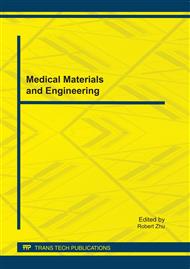p.38
p.43
p.48
p.53
p.58
p.63
p.68
p.74
p.78
Surface Modified Polylactic Acid Microspheres Reinforced Calcium Alginate Hydrogels
Abstract:
Calcium alginate hydrogels, offering cells with three dimensional growing environments similar to that experienced in vivo, is an appealing materials utilized as scaffolds in tissue engineering. However, how to improve its mechanical property and expand its use is becoming an urgent topic that draws great attention. In this paper, we introduced polylactic acid (PLLA) microspheres, treated by surface aminolysis, into calcium alginate hydrogels that was fabricated by the methodology of in-situ release and transformation. The surface aminolysis modification improved the hydrophilicity of PLLA microspheres, which increased the integration between PLLA microspheres and calcium alginate hydrogels. Within the composite hydrogels, PLLA microspheres can play the role of hindrance for the extension of cracks and improve its mechanical strength. Meanwhile, PLLA microspheres can also be used as hydrophobic drugs delivery vehicles to transport gene, protein, peptide and the like. In this way, with the enhancement of mechanical strength and newly given functions, the fields in which the composite hydrogels can be applied can be broadened significantly.
Info:
Periodical:
Pages:
58-62
Citation:
Online since:
November 2011
Authors:
Keywords:
Price:
Сopyright:
© 2012 Trans Tech Publications Ltd. All Rights Reserved
Share:
Citation:


